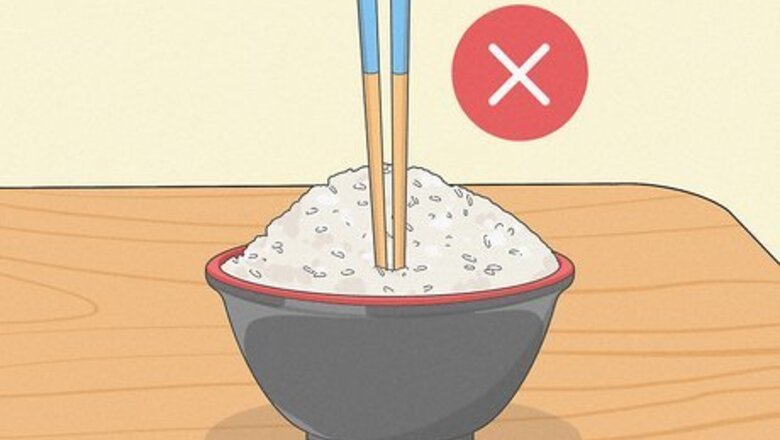
views
- Set your chopsticks on the table instead of upright in your dish when you’re not eating. Sticking up chopsticks vertically resembles a traditional funeral rite.
- Share a bite of food on a dish instead of passing it from your chopsticks to theirs. This is a taboo reminder of cremations and funerals in Japan.
- Refrain from rubbing disposable chopsticks together after you break them apart. This can insult your host, signaling that you think their chopsticks are cheap.
Do not place your chopsticks vertically in your dish.
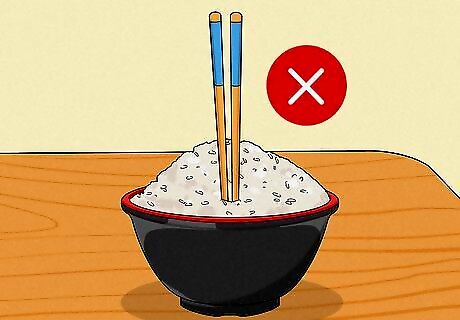
Standing up your chopsticks in a dish mirrors a traditional funeral rite. When you need to put your chopsticks down, place them side by side on the table next to your bowl or plate. During Japanese funerals and memorials, people offer up food to passed loved ones by sticking incense into a bowl of rice. So, sticking your chopsticks vertically in your dish is a reminder of death and is seen as disrespectful. Do not rest your chopsticks directly on the table either, as that’s seen as unsanitary. Instead, use a chopstick rest to elevate your utensils off the table if the restaurant or your host offers one. Or, rest them on a napkin. If you’re using disposable chopsticks, make your own rest by folding the paper wrapper in thirds lengthwise. Then, fold it in half horizontally to create an upside-down V shape to rest your chopsticks on. In Japan, it’s good table manners to position your chopsticks horizontally below your dishes instead of vertically beside them. In Korea, it’s more common to position your chopsticks vertically.
Avoid passing food from your chopsticks to someone else’s.
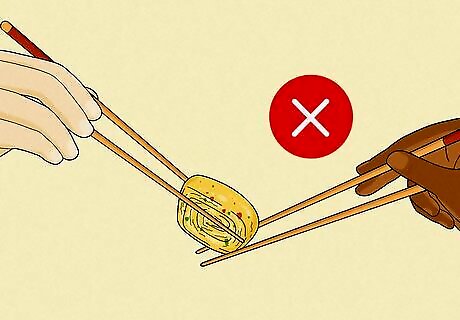
Trading food between chopsticks is considered taboo in Japan. If you want to give a friend a bite of your food to try, place it on a plate or bowl instead of transferring it from your chopsticks to theirs. This is seen as a disrespectful reminder of traditional cremations in Japan, where 2 family members use a pair of special chopsticks to pick up and place the bones of their loved ones into an urn. In Japanese, the word “hashi” means both “chopsticks (箸)” and “bridge (橋).” Carrying a loved one’s bones with chopsticks symbolizes their souls crossing the bridge to heaven. Bringing up anything related to death while eating is a no-no in Japanese and other Asian cultures. It’s believed to bring bad luck and can ruin a happy dinner atmosphere.
Resist rubbing your chopsticks together after breaking them apart.
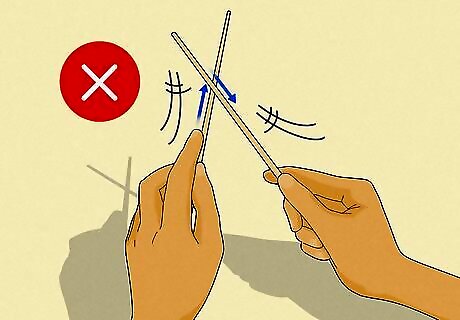
Rubbing your chopsticks to remove splinters is considered rude. Whether you’re dining in a restaurant or eating at a friend’s home, rubbing your chopsticks together can suggest that you think the chopsticks are cheap and cause splinters or blisters. This is insulting to your host and can make it seem like you don’t think highly of them. In Japan, you break apart disposable chopsticks by holding them horizontally (pulling up and down) instead of vertically (pulling left and right). This is seen as polite and prevents you from accidentally elbowing your neighbor. When you’re done with disposable chopsticks, place them back inside the paper wrapper. If you know a restaurant offers disposable chopsticks that you don’t like using, bring a pair of your own chopsticks to avoid the urge to rub them together.
Lay your chopsticks on the table instead of across your dish.
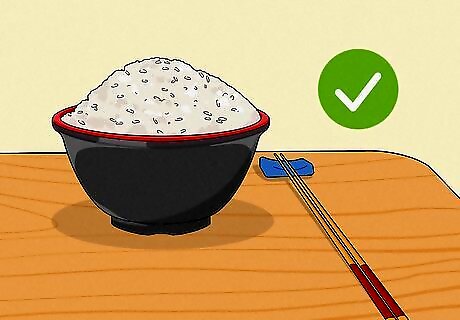
Placing chopsticks across a dish is a sign that you’re done eating. If you’re still enjoying your meal, set your chopsticks on a rest instead of placing them across your plate or bowl. Crossing your chopsticks signals that you’re finished with your meal, so your server or host might take away your dish. In more formal restaurants and gatherings, laying your chopsticks across your bowl can show a lack of respect for your utensils and the dish. Laying your chopsticks across your dish also leaves them in a precarious position—if you accidentally bump your bowl, they might fall.
Avoid stabbing your food with your chopsticks.
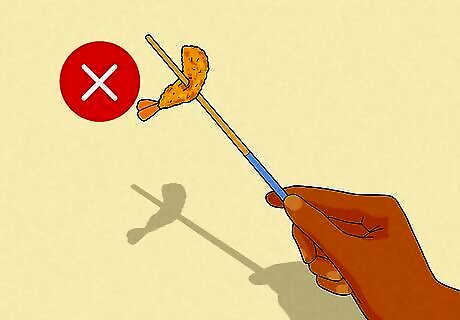
Using your chopsticks as a skewer is considered bad table manners. If you’re having trouble picking up a piece of food with your chopsticks, ask for help or for different utensils instead of using them to pierce through the food. Most foods in Japan and other countries like China and Korea are made with chopsticks in mind, so using them as a DIY kebab is viewed as bad form and impolite. When eating larger pieces of food, it’s completely fine to take multiple bites of it while holding it with your chopsticks. If you want to cut your food, politely ask if you can get a knife. It can be considered rude to cut your food with your chopsticks. In countries like Japan and China, it’s acceptable to bring a bowl up to your face and use your chopsticks to scoop the food into your mouth. Just don’t shove the food into your mouth, as that’s also seen as rude.
Refrain from taking shared food with used chopsticks.

Using your chopsticks to take from a shared dish is seen as unsanitary. In many Japanese and other Asian restaurants, you order multiple dishes to share between you and your guests. Most dishes are served with a designated set of chopsticks for scooping the food onto your bowl or plate. If there aren’t a pair of chopsticks in the dish, use a clean set of chopsticks to transfer the food to your plate instead of using the chopsticks you’re eating with. If there aren’t an extra pair of clean chopsticks to serve the food, use the opposite end of your own chopsticks to scoop the food onto your plate. Do not eat directly from shared dishes, either. Instead, pick up the food with shared chopsticks and put it on your plate or bowl.
Do not search through shared dishes with your chopsticks.

Take food from the top of shared dishes instead of rifling through them. Poking your chopsticks in search of the best bites of food in shared dishes is considered rude. This suggests to your dinner companions that some of the food isn’t good enough for you, which can insult your host or the chef at the restaurant. Searching through shared dishes can also make it seem like you’re leaving your friends with less than desirable bites to eat, which can make you look selfish.
Put down your chopsticks to avoid pointing at people with them.

Pointing at people with your chopsticks is seen as impolite. You wouldn’t point at your friends or dinner guests with a fork or knife, so don’t point at them with your chopsticks, either. If you need to get someone's attention or clarify who you’re talking about, put down your chopsticks and simply call their name instead. Gesturing or talking with your chopsticks is also considered a no-no in Japan. If you notice you’re waving them around, lay them down when you’re not eating. When you put down your chopsticks on the table, make sure they don’t point towards anyone either, as this is also seen as rude.
Avoid chewing on or holding your chopsticks in your mouth.

Holding your chopsticks in your mouth is seen as unhygienic. If you’re eating but need to pass a dish to someone else, don’t stick your chopsticks in your mouth for safekeeping. Holding them in your mouth, or even chewing on them, is seen as just as impolite as holding a fork, knife, or spoon in your mouth.
Do not move bowls and dishes with your chopsticks.

Reserve your chopsticks for only picking up and eating food. Using your chopsticks to pull a dish closer to you is viewed as disrespectful to your host’s tableware, as pulling it with your chopsticks can cause the dish to fall over or the contents to spill across the table. If you need to bring a dish closer to you, put down your chopsticks and then pick it up. Or, ask someone to hand it to you. If you slip up, don’t be hard on yourself. Know that people in Japan and other Asian countries don’t always follow chopstick etiquette to a T and forget their manners sometimes too!
Resist the temptation to play with your chopsticks.
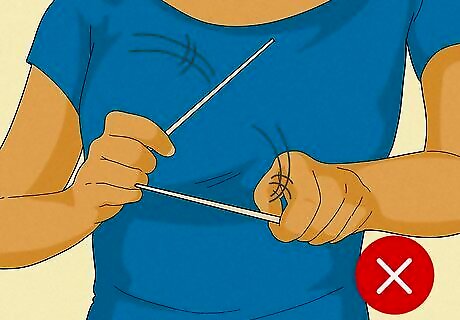
Drumming or waving your chopsticks is seen as rude and childish. In most Western countries, you would never play with your fork, knife, or spoon at the dinner table. So, don’t joke or mess around with your chopsticks, either. This can seem like you’re disrespecting Japanese or other Asian cultures and cause you to embarrass your dinner guests. Playing with your chopsticks can also cause you to drop them. Besides being wasteful, dropping your chopsticks is also believed to be a bad omen.
Think about what you want to eat before you serve yourself.
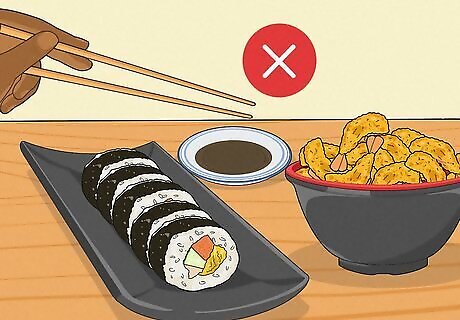
Hovering chopsticks indecisively over food can make you seem greedy. When you’re trying to decide what to eat next, think about what looks good before grabbing the chopsticks. Indecisively waving your chopsticks back and forth over the food can look rude to others and seem like you want all of the food for yourself. Hovering over the dishes can also be annoying to your dinner companions, as you might prevent them from taking food when they know what they want.
Do not lick food off of your chopsticks.
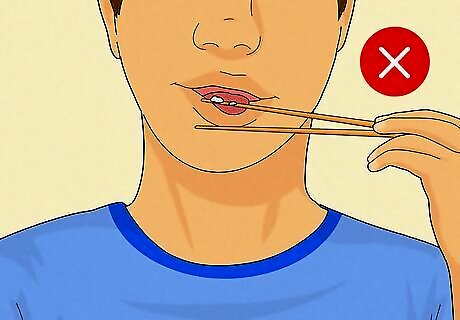
Biting off morsels of food from your chopsticks is considered improper. If you have bits of rice or other food sticking to the ends of your chopsticks, ignore them and keep eating your food like normal. Stopping to lick off the food is considered bad manners and can look gross or vulgar to your dinner guests. If the pieces of food are bothering you, wipe them off with a napkin instead of continuing to eat with them on the end of your chopsticks.
Use your chopsticks properly.
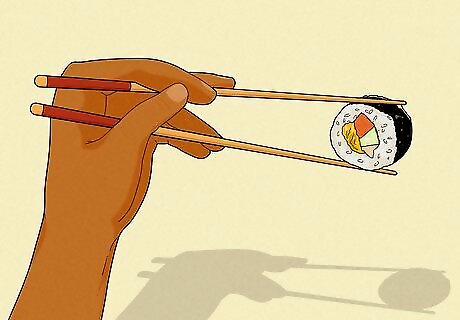
Holding your chopsticks correctly helps you master dining etiquette. Place the first chopstick between your dominant hand’s thumb and ring finger. Then, add the other chopstick on top, gripping it between your thumb, index, and middle finger. To pick up food, simply use your index and middle finger to move the top chopstick open while keeping the bottom chopstick still. It’s traditional to clasp your hands together and say “Itadakimasu (頂きます)” before you eat in Japan, which means, “I humbly receive” or “Let’s eat!” When you pray, put down your chopsticks. Use the same-sized chopsticks when you eat as eating with different-sized ones can be a sign of bad luck. If you’re given mismatched chopsticks, ask if you can get a matching set. If you’re having trouble using chopsticks, switch to a pair of training chopsticks. These utensils are attached at the top, which makes it easier to pick up your food while also building your dexterity.

















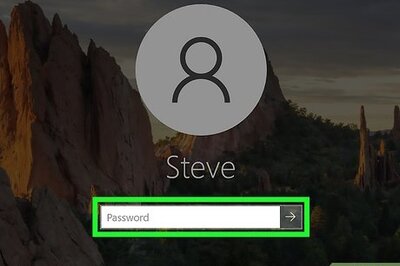
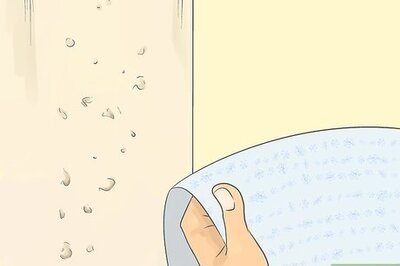
Comments
0 comment